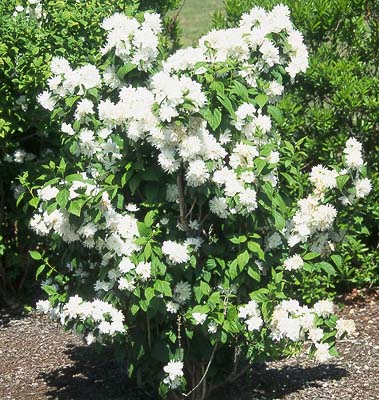My favorite flowering shrub is mock orange. Its botanical name is Philadelphus coronarius, with several species and hybrids. Its scent is sweet and enticing, and fills the air on a humid day. It reminds me of hot, childhood summers running through the lawn edged in a hedge of mock orange. A multi-stemmed shrub that can be pruned to keep it in bounds, or shaped for a more formal design. Some species are about ten feet tall while others have been tamed with breeding to be dwarfed. All have a wonderful clean, white flowers with four petals and yellow stamens, blooming late May to early June. The bark is exfoliating, turning a reddish-brown in winter providing interest once the leaves drop.
The older, single flowered varieties are more fragrant than the new crosses and hybrids. A favorite dwarf of mine is ‘Miniature Snowflake’ that combines both a dense habit, shorter four-foot height and very good fragrance. The white flowers are double and foliage a dark green.
All species do well in full sun or light shade. They are pH and soil adaptable, but like moist, well-drained soil high in organic matter. All respond well to pruning by producing new growth with lots of flowers. Mock oranges are not bothered by any pests severely, tolerating the common aphid invasions and once in a while, leaf miners. Basically, reliable old-fashioned shrub with great scent.
-Carol Quish




June 13, 2013 at 2:54 am
Hi Carol!
You might recall the report of the Mock Orange I found in the woods near the Coginchaug River here in Middletown. Additional photographs your readers might enjoy (from my Flickr page):
http://tinyurl.com/kpayy52
http://tinyurl.com/kcobfzs
http://tinyurl.com/kff6n7a
June 15, 2013 at 12:06 am
Thank you John.
September 5, 2014 at 3:09 am
Hi Carol,
I found this site when looking up mock orange. Can you look at my web site… http://solarbeez.com/2014/09/04/late-summer-blossoms/ and tell me what kind of mock orange this could be? A reader was surprised the tree was so tall. I’ve looked at the mock orange trees and bushes on “images” but they are all much smaller. The flower fits the description, but the size of the tree seems too big. The tree is in Bandon, Oregon (west coast USA) The video at the end shows the bees pollinating it. I’m a beekeeper (more of a bee guardian) who shoots videos of what my bees might be up to.
Thanks,
Pat aka solarbeez
September 8, 2014 at 2:33 pm
Hello Pat,
I don’t think the tree you are calling by the common name ‘Mock Orange’ is in the genus Philadelphus. I think it is Eucryphia. See the article I found from a Portland, Oregon newspaper. http://www.portlandmonthlymag.com/home-and-garden/articles/september-10-eucryphia
Regards,
Carol Quish
UConn Home and Garden Education Center
September 8, 2014 at 4:57 pm
Can I quote you in my comments and link your site to correct the record?
Thanks,
Pat
September 9, 2014 at 6:02 am
[…] August 22, 2014…I finally visited Barbara’s Mock Orange tree. It was everything she said it was. Covered in white blossoms with bees all over it. Note: this might NOT be a Mock Orange. See below what Carol Quish of University of Connecticut had to say. […]
September 9, 2014 at 4:43 pm
Pat, yes you can quote and link this site and me.
Carol